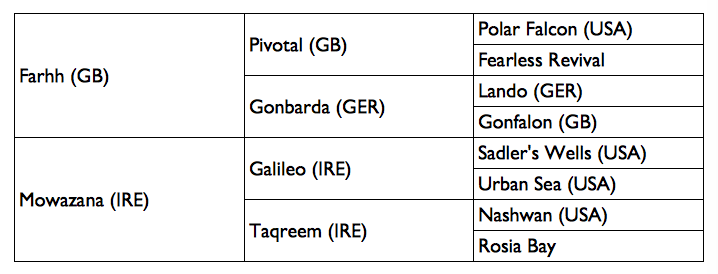|
Those who have come into the industry in the past quarter of a century may be so used to seeing large books of mares and resulting foal-crop sizes that they could be forgiven for thinking this is how it always was.
But before numbers exploded to these somewhat recent levels, the norm was that a popular flat stallion covered 40 mares in a season, and maybe a few more. There was even some consternation in the 1980s when one high-profile new recruit was to get a book of 50 – hard to believe now. Times have changed, of course, and so although his first crop of 38 foals would have been normal in the past, it is a number that placed Dalham Hall Stud's Group 1 star Farhh (by Pivotal) at somewhat of a disadvantage in challenging for prominence among the freshman sires of 2017. He won one of two starts as a juvenile, one from three as a three-year-old, was multiple Group 1-placed at four and only hit his peak at the age of five when he took both the Group 1 Lockinge Stakes and Group 1 Champion Stakes. That is the racing profile of a stallion of whom you'd expect no more than a handful of late-season two-year-old winners, one whose stakes and pattern winners would start to emerge over a mile and upwards at three and beyond. And yet Farhh's handful of first-crop runners has so far yielded two blacktype horses, one a stakes-placed runner in Italy and the other one being Group 3 Tattersalls Acomb Stakes scorer Wells Farhh Go. The colt's only prior outing was in a novice auction event over the same course and distance a month before, a race he won by two and a quarter lengths.
It remains to be seen just what he achieved in getting up on the line to pip James Garfield by a nose, although it is encouraging that the pair finished three and three-quarter lengths clear of third-placed Lansky, a colt who had won a Windsor maiden on his only previous start.
Wells Farhh Go was bred by Maria Marron, he made just €16,000 when sold in Goffs as a foal, and he is trained by Tim Easterby, who picked him up for 16,000gns from Book 3 of the Tattersalls October Yearling Sale. Given that he cost so little yet is by a top-class son of the sire of leading stallions Siyouni and Kyllachy, you might expect that the distaff side of his family is weak, and despite the high-profile horses that appear on the lower half of the page, it is a fair comment. His third dam is Rosia Bay (by High Top), the dam of Group 1 Yorkshire Oaks heroine Roseate Tern (by Blakeney) and of Grade 1 Breeders' Cup Classic runner-up and four-time European Group 1 star Ibn Bey (by Mill Reef), and so the many smart horses who appear in the branches of that generation of the family include Group 1 Fillies' Mile heroine Red Bloom (by Selkirk) and classic-placed pattern scorer Red Camellia (by Polar Falcon). The fourth dam is Ouija (by Silly Season), which means that Rosia Bay was a half-sister to Grade 1 winner Teleprompter (by Welsh Pageant) and to Selection Board (by Welsh Pageant) – the mare who gave us the brilliant Ouija Board (by Cape Cross) and her Derby-winning son Australia (by Galileo). But despite all of this, Wells Farhh Go represents a branch of the family that has been largely unremarkable. His grandam, Taqreem (by Nashwan), failed to win and although she has produced seven winners from 13 foals – one of whom is his dam Mowazana (by Galileo) – her only blacktype horse is the listed-placed Ma-Arif (by Alzao), a one-time winner whose grandson, Rangali (by Namid), was the only stakes winner in the first two generations of the pedigree until York. That colt beat Catcall by two lengths in the Group 2 Prix du Gros-Chene in 2014, was a head runner-up to Move In Time in the Group 1 Prix de l'Abbaye de Longchamp later that year, and was beaten a short-neck by Goldream in the same race 12 months later. Now aged six, he has been below par in a trio of stakes races in 2017. Wells Farhh Go is the sixth foal of his dam, he is a half-brother to several winners, and he holds an entry in the Group 2 Juddmonte Royal Lodge Stakes later this month. It will be interesting to find out just how good he is, and one could reasonably expect that, on pedigree, he will progress at three and perhaps four years of age, likely proving best at around eight to 10 furlongs. |
Archives
September 2018
Sires
All
|

 RSS Feed
RSS Feed